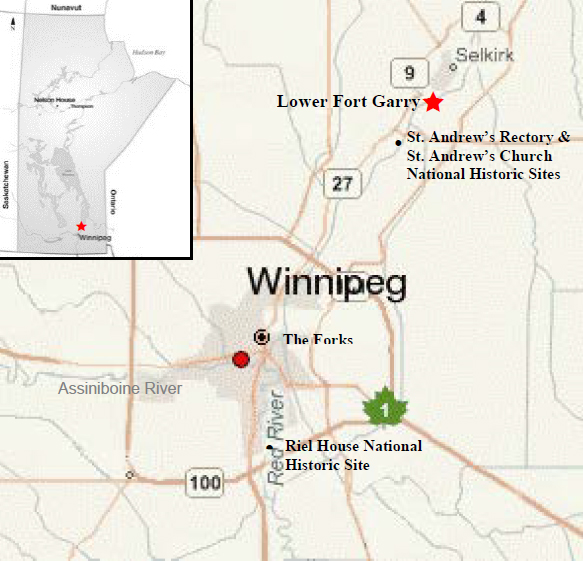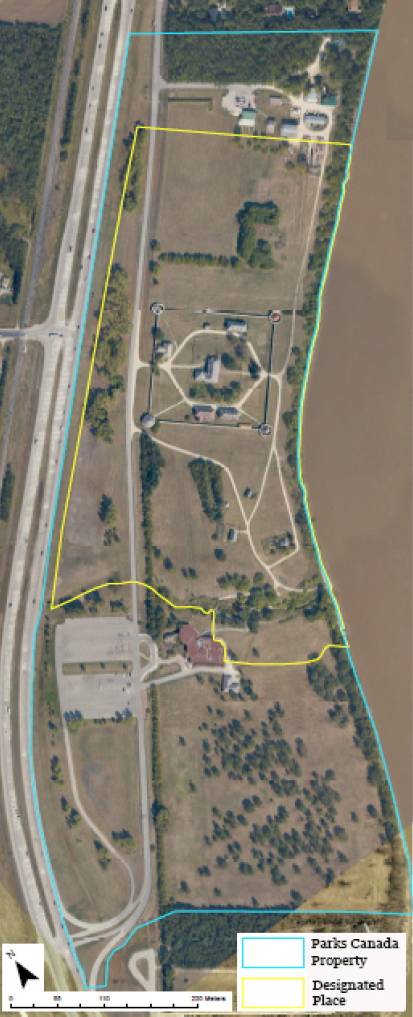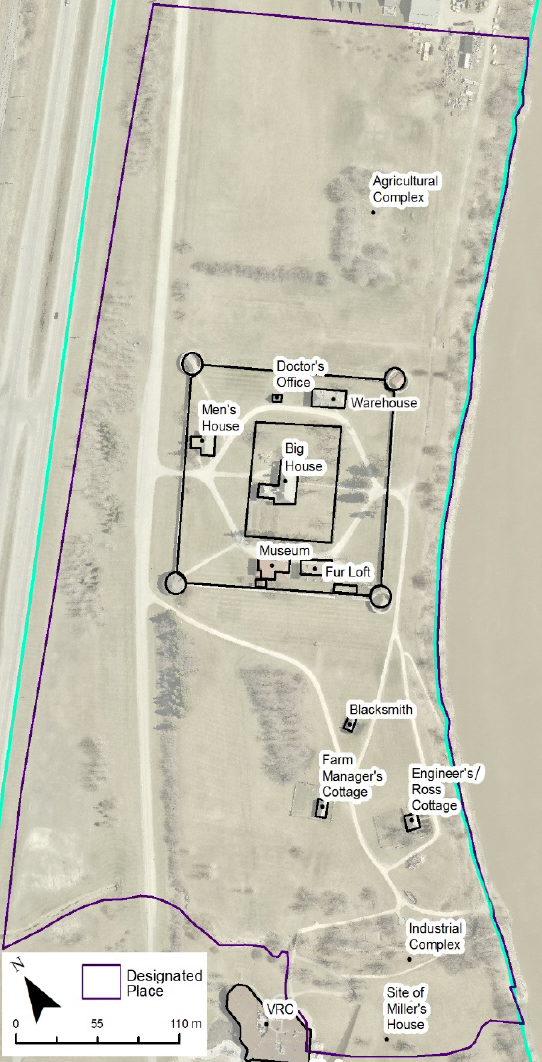Lower Fort Garry National Historic Site of Canada Management Plan, 2018
Lower Fort Garry National Historic Site
Table of contents

© Her Majesty the Queen in Right of Canada, represented by the Chief Executive Officer of Parks Canada, 2018.
Cette publication est aussi disponible en français.
National Library of Canada cataloguing in publication data:
Parks Canada
Lower Fort Garry National Historic Site of Canada Management Plan 2018
Issued also in French under the title:
Plan directeur du lieu historique national du Canada de Lower Fort Garry 2018
- ISBN R64-105/59-2018E-PDF
- Cat. no. 978-0-066-26488-2
For more information about the management plan or about Lower Fort Garry:
5925 Highway 9
St. Andrews, MB R1A 4A8
Front cover image credits
Top from left to right: Parks Canada
Bottom: Parks Canada
Foreword

Canada’s national parks, national historic sites and national marine conservation areas belong to all Canadians and offer truly Canadian experiences.
These special places make up one of the finest and most extensive systems of protected natural and cultural heritage areas in the world.
The Government is committed to preserving our natural and cultural heritage, expanding the system of protected places and contributing to the recovery of species-at-risk. At the same time, we must continue to offer new and innovative visitor and outreach programs and activities so that more Canadians can experience Parks Canada places and learn about our environment, history and culture.
This new management plan for Lower Fort Garry National Historic Site of Canada supports this vision.
Management plans are developed through extensive consultation and input from various people and organizations, including Indigenous Peoples, local and regional residents, visitors and the dedicated team at Parks Canada.
National parks, national historic sites and national marine conservation areas are a priority for the Government of Canada.
I would like to thank everyone who contributed to this plan for their commitment and spirit of co-operation.
As the Minister responsible for Parks Canada, I applaud this collaborative effort and I am pleased to approve the Lower Fort Garry National Historic Site of Canada Management Plan.
Recommendations
Recommended by and original signed by
Daniel Watson
Chief Executive Officer,
Parks Canada
Gatineau, Canada
Trevor Swerdfager
Senior Vice-President,
Operations
Parks Canada
Elvis Riou
A/Field Unit Superintendent
Manitoba Field Unit
Parks Canada
Executive summary
On the west bank of the Red River, 32 km north of Winnipeg, sits Lower Fort Garry National Historic Site. The fort was established in 1830 and operated as a Hudson’s Bay Company post until 1911, serving as a hub for First Nation and Métis trappers and HBC traders. The original stone buildings still stand, ringed by limestone walls, faithfully restored by Parks Canada.
The fort was designated in 1950 and commemorates one of the finest collections of early stone buildings in Western Canada; the place where Treaty Number One was made; an important Hudson's Bay Company centre for industry and transshipment; and its later use by the federal government for public purposes, including its use as the first training base for the North West Mounted Police.
This management plan replaces the 2007 Management Plan for Lower Fort Garry National Historic Site and builds on the Parks Canada’s previous commitments and management plan objectives.
The three key strategies, written as outcome-based results, are outlined in this new plan for the ten-year management plan period:
- Key Strategy 1: Collaboration and expanded presentation of First Nation and Métis culture on site.
Lower Fort Garry is a welcoming place with authentic experiences and learning opportunities for all Canadians. Parks Canada collaborates with Treaty No. 1 First Nations and the Manitoba Métis Federation so that their perspectives and knowledge are incorporated into management planning, decision making, and programming. Multi-perspective history and First Nation and Métis culture is accurately presented and celebrated on site.
- Key Strategy 2: A renewed visitor experience is offered at Lower Fort Garry National Historic Site.
Lower Fort Garry National Historic Site offers an outstanding visitor experience through contemporary interpretive and visitor programs, with an added focus on First Nation and Métis content. Key special events generate traffic in desired target markets and provide an opportunity to promote daily interpretive programming, increasing site visitation overall.
- Key Strategy 3: The condition of assets and cultural resources is maintained or improved.
Preservation of the site is achieved through active cultural resource conservation and asset investments. Strategic asset investments reflect the principle of sustainability and guide decision-making. Current and planned asset work is incorporated into the interpretation of the site and capitalizes on the well- maintained buildings and other historical resources.
1.0 Introduction
Map 1. Regional setting of Lower Fort Garry

Image description
Lower Fort Garry National Historic Site, located in southern Manitoba, is a former Hudson’s Bay Company fur trade post, once the most extensive in western Canada.
The historic stone fort, situated 32 km upstream from Winnipeg, was established in 1830 and operated as a company post until 1911. Throughout its long history, Lower Fort Garry has been a symbol for Western Canada and its growth.
Parks Canada manages one of the finest and most extensive systems of protected natural and historic places in the world. The Agency’s mandate is to protect and present these places for the benefit and enjoyment of current and future generations. Future- oriented, strategic management of each national park, national marine conservation area, heritage canal and those national historic sites administered by Parks Canada supports the Agency’s vision:
“Canada’s treasured natural and historic places will be a living legacy, connecting hearts and minds to a stronger, deeper understanding of the very essence of Canada.”
The Parks Canada Agency Act requires Parks Canada to prepare a management plan for national historic sites administered by the Agency. The Lower Fort Garry National Historic Site of Canada Management Plan, once approved by the Minister responsible for Parks Canada and tabled in Parliament, ensures Parks Canada’s accountability to Canadians, outlining how historic site management will achieve measurable results in support of the Agency’s mandate.
The plan sets clear, strategic direction for the management and operation of Lower Fort Garry National Historic Site by articulating a vision, key strategies and objectives. Parks Canada will report annually on progress made towards achieving the plan objectives and will review the plan every ten years or sooner if required.
This plan is not an end in and of itself. Parks Canada will maintain an open dialogue on the implementation of the management plan to ensure that it remains relevant and meaningful. The plan will serve as the focus for ongoing engagement on the management of Lower Fort Garry National Historic Site in years to come.
2.0 Significance of Lower Fort Garry National Historic Site
Frequent and catastrophic flooding at the junction of the Assiniboine and Red Rivers (present day Winnipeg) prompted the Hudson’s Bay Company (HBC) to seek a new area to establish a base of operations. Constructed between 1830 and 1850, Lower Fort Garry evolved to play a key role as a supply, transportation and distribution centre effectively fuelling the HBC’s expansion into the Canadian west.
Lower Fort Garry National Historic Site was designated of national historic significance in 1950 because:
- It was the place where Treaty No.1 was made between the Saulteaux (Anishinaabe/Ojibway) and Swampy Cree First Nations people and the Crown (1871);
- It is one of the finest collections of early stone buildings in Western Canada;
- As a Hudson’s Bay Company post, it was a focus for industry and transport, as well as a supply and distribution centre for the fur trade of the company’s Northern Department; and
- It was used by the federal government for public purposes in the 1870s, notably as the first training base for the North West Mounted Police (1873-1874).
In addition to its reasons for designation, the fort’s later use by the federal government for public purposes is also significant. Notably, the fort housed a federal prison from 1871-1877, Manitoba’s first mental health facility in 1884-1886 and between 1913 and 1962 it was the home for the Manitoba Motor Country Club. In 1951, the Hudson Bay Company donated the complex and its associated land to Parks Canada. Between 1965 and 1982 many of its structures were restored to the 1850s period.
Six of the structures at the site have Federal Heritage Building Review Office status: the Warehouse, Men’s House, Museum Building, and South-West Bastion are ‘recognized’ Federal Heritage Building Review Office buildings and the Sales Shop/Fur Loft and Big House are ‘classified’ Federal Heritage Building Review Office buildings.
Other important heritage buildings on site include the Doctor’s Office inside the fort walls, and Ross Cottage and Fraser House outside the walls. The Blacksmith Shop outside the walls is an important reproduction building.
The area near Lower Fort Garry is significant to local First Nation and Métis communities. Their history is closely tied to the history of the fur trade and the fort. As a mix of traditional hunters, trappers, traders and farmers, local First Nation and Métis people helped supply the fort with food and goods and worked seasonally at the fort, or for the Hudson Bay Company.
Map 2. Lower Fort Garry National Historic site map
Parks Canada 2017

Image description
Map 3. Buildings within the designated place of Lower Fort Garry National Historic Site
Parks Canada 2017

Image description
3.0 Planning context
Lower Fort Garry National Historic Site is managed by Parks Canada’s Manitoba Field Unit at the Lower Fort Garry Visitor Centre and at the Parks Canada offices in Winnipeg. In addition to Lower Fort Garry National Historic Site, the field unit administers Wapusk National Park and The Forks, St. Andrews Rectory, Riel House, Prince of Wales Fort and York Factory National Historic Sites. The field unit also manages three other non- operational national historic sites: Linear Mounds, Battle of Seven Oaks, and Forts Rouge, Garry and Gibraltar National Historic Sites.
Lower Fort Garry National Historic Site is open to the public for school programs and special programming in May and June, and for regular heritage programming daily in July and August. The on-site restaurant, operated by a business licensee, is open during the summer season and provides catering for events. Lower Fort Garry is available for site rentals and conducts special events throughout the year.
In 2013, the operating season was shortened and a series of changes to the product offer and hours of operation were implemented. Ways to increase the heritage experience and appeal of Lower Fort Garry are continually investigated. The site has a modest but steady annual visitation averaging approximately 30,000 visitors, and contributes to the regional tourism community as the only historical site in the area that offers a permanent, authentic Indigenous tourism offer.
Lower Fort Garry is committed to all people for whom the site holds special meaning. In 2010 a dedicated position was added to ensure that the seven Treaty No.1 First Nations and the Manitoba Métis Federation maintained their connection with the site in a meaningful way, including access to perform ceremonies and celebrations on site. The site is a place for First Nations and Métis people to share their history and stories with visitors in an authentic way and build understanding.
Since the 2007 Lower Fort Garry Management Plan, over 90% of the actions and recommendations of that plan have been implemented, or have been initiated and remain ongoing. Relationships with First Nation communities, Métis citizens, stakeholders and tourism partners will continue to be nurtured and developed. Parks Canada continues to collaborate with others in the development of historic and Indigenous related on-site programming and Treaty education materials. The site continues to be a welcoming and open venue which has hosted many special Parks Canada, third-party, and Indigenous-led events.
Significant improvements and reduction of risk to site infrastructure has occurred in the last ten years. Following the last plan, stabilization efforts and archaeological investigations were completed along the banks of Monkman Creek. More recently, as part of a Federal Infrastructure Program, rehabilitation work was performed on the stone walls; fire suppression and electrical deficiencies were addressed in three heritage buildings; and the site’s independent water and waste-water systems were replaced.
Barrier-free accessibility has been improved in many areas of the site. Many of the stanchions and gates within the heritage buildings have been removed and accessible washrooms and a lift have been added to the Big House.
4.0 Vision
The vision presented below expresses the desired state of Lower Fort Garry National Historic Site in 10-15 years.
Lower Fort Garry National Historic Site is a welcoming and accessible historical centrepiece in the Winnipeg region. The site’s rich cultural and historical commemorative elements, the foundation of its story, are shared with visitors through on-site interpretive programming and outreach education.
Authentic experiences and learning opportunities are presented onsite through respectful and collaborative relationships with First Nation and Métis peoples. Treaty No.1 First Nations and citizens of the Manitoba Métis Federation share their history, stories, and traditions with visitors. The site presents varied perspectives on its history, its reasons for designation, and commemorates the history of the area and its residents. Increased visitation and revenue at Lower Fort Garry National Historic Site is achieved through a renewed and contemporised visitor experience built upon tourism industry research and the development and promotion of programs aimed at desired target markets. Distinct special events, delivered in partnership with the First Nations, Métis, and stakeholder organizations augment the site’s revenue and provide new and existing audiences a reason to return to the site, without compromising the commemorative integrity of the site, its cultural resources, and heritage value.
New mutually-beneficial partnerships are established, expanding the visitor experience offer to attract new and under-represented markets to the site. Lower Fort Garry National Historic Site is established as a desired location in the meetings and conventions industries and the market reach within these business lines is increased.
Active preservation initiatives support and protect the resources at Lower Fort Garry National Historic Site. These activities are incorporated into the visitor experience programming as part of the ongoing story of this remarkable place.
5.0 Key strategies
Key strategy 1:
Collaboration and expanded presentation of First Nation and Métis culture on site.
Lower Fort Garry is a welcoming place with authentic experiences and learning opportunities for all Canadians. Parks Canada collaborates with Treaty No. 1 First Nations and the Manitoba Métis Federation so that their perspectives and knowledge are incorporated into management planning, decision making, and programming. Multi-perspective history and First Nation and Métis culture is accurately presented and celebrated on site.
Objective 1:
Treaty No.1 First Nation peoples and Métis citizens engage in traditional and cultural activities and share their perspectives at Lower Fort Garry.
Targets:
- Treaty No.1 First Nation peoples and Métis citizens use the site to have celebrations, perform ceremonies, and actively share their stories and traditions related to the site.
- Interpretive programming is reflective of Treaty No.1 First Nation and Métis history and perspectives.
- The majority of First Nation and Métis programming is created and presented members of those cultures who have a historical connection to the site.
- Lower Fort Garry is recognized by the tourism industry for its high quality, authentic experiences.
- Parks Canada works with Treaty No.1 First Nations and the Manitoba Métis Federation to fulfill land entitlement claims and support rights recognition.
- Outreach and education related to the site, its cultural resources and history, includes First Nation and Métis content and is shared offsite with the public including in local communities, and for First Nation and Métis youth.
Objective 2:
Strong collaborative partnerships are in place with Treaty No.1 First Nations and the Manitoba Métis Federation.
Targets:
- An integrated communication process is developed with Treaty No.1 First Nation communities and the Manitoba Métis Federation which is effective, timely and enhances the relationship. Discussion points include the presentation of history and culture on-site, potential First Nation and Métis economic opportunities, and employment strategies for First Nation peoples and Métis citizens.
- First Nation and Métis partners develop market-ready, tourism products and experiences for the site with support and collaboration from Parks Canada and are aware of, and benefit from, the economic opportunities these products afford.
Key strategy 2:
A renewed visitor experience is offered at Lower Fort Garry National Historic Site.
Lower Fort Garry National Historic Site offers an outstanding visitor experience through contemporary interpretive and visitor programs, with an added focus on First Nation and Métis content. Key special events generate traffic in desired target markets and provide an opportunity to promote daily interpretive programming, increasing site visitation overall.
Objective 1:
The Visitor experience offer is built around target markets in response to their needs and desires.
Targets:
- Site visitation has increased by 10%.
- Site-specific target markets are determined through tourism industry reports for the region.
- Programming success is evaluated post-season and is used to guide future program development.
- The number of unique special events delivered in partnership with outside organizations has increased.
- Collaborations exist between Parks Canada and regional destination marketing organizations (e.g. Travel Manitoba and the Indigenous Tourism Association of Canada) for outreach, promotion, and programming products.
Objective 2:
Innovative visitor experience opportunities and cross-promotion increases the amount of repeat visitation.
Targets:
- The visitor experience offer is frequently refreshed and renewed with contemporary onsite interpretation delivery methods.
- The site’s unique and authentic tourism offer has been strengthened.
- Standard programs and value-added programs are promoted in conjunction with onsite special events.
Key strategy 3:
The condition of assets and cultural resources is maintained or improved.
Preservation of the site is achieved through active cultural resource conservation and asset investments. Strategic asset investments reflect the principle of sustainability and guide decision-making. Current and planned asset work is incorporated into the interpretation of the site and capitalizes on the well-maintained heritage buildings and other cultural resources.
Objective 1:
The majority of site infrastructure is restored and maintained in good condition.
Targets:
- The “poor” condition of assets and cultural resources that are key to visitor experience improve to “Good” in the next State of the Site Report as Parks Canada strategically invests in its assets.
- Rehabilitation and site upgrades are incorporated into visitor experience programming, telling the ongoing story of the site.
6.0 Summary of the strategic environmental assessment
Parks Canada is responsible for assessing and mitigating the impacts of management actions on ecosystems and on cultural resources. The Cabinet Directive on the Environmental Assessment of Policy, Plan and Program Proposals prepared by the Canadian Environmental Assessment Agency, requires a strategic environmental assessment of all plans and policy submitted to the federal Cabinet or to a Minister for approval deemed to have important positive or negative environmental effects.
A strategic environmental assessment was undertaken on this management plan, and the management direction found within has been adjusted to respond to findings. The following is a summary of the environmental assessment:
The spatial scope of the strategic environmental assessment included areas within the boundary of Lower Fort Garry National Historic Site, and the temporal scope was a period of ten years from the date of plan approval, at which time the plan will be reviewed. The resources considered to be Valued Components are the cultural resource elements commemorated and protected by the historic place designation, the fortifications, the historic buildings, the archaeological sites and the west bank of the Red River. Visitor experience resources including the various facilities are also important resources considered in the assessment.
The management plan includes a number of important initiatives to build relationships with First Nations and the Métis, demonstrate leadership in reconciliation and create opportunities for strengthening diversity and inclusion. These initiatives will help create understanding of the First Nation and Métis values of the site and will help tell a more complete story of the site to Canadians.
A significant positive effect of the Management Plan will be to expose Lower Fort Garry National Historic Site to more visitors, improving awareness and appreciation of the historic value of the site. Enhanced stability and conservation of the resources at these sites will contribute to the mandate of the Agency and overall quality of the visitor experience, as will improvements to contemporary visitor facilities. Any potential negative environmental effects from increased visitation can be mitigated through the use of existing policies and instruments and by carefully managing visitor use of the areas.
Project-level environmental impact assessments will be able to mitigate any potential adverse impacts from individual projects resulting from this plan.
If the appropriate mitigation measures are applied, there are no significant adverse environmental effects anticipated from implementation of the management plan. The overall environmental effects of the strategies, objectives and targets of the plan are expected to be positive.
Related links
- Date modified :